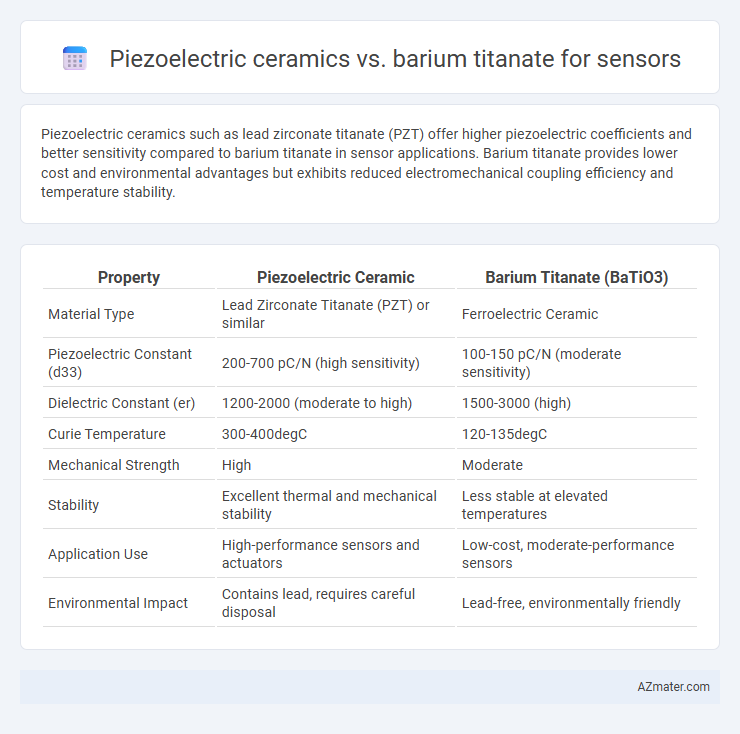Piezoelectric ceramics such as lead zirconate titanate (PZT) offer higher piezoelectric coefficients and better sensitivity compared to barium titanate in sensor applications. Barium titanate provides lower cost and environmental advantages but exhibits reduced electromechanical coupling efficiency and temperature stability.
Table of Comparison
| Property | Piezoelectric Ceramic | Barium Titanate (BaTiO3) |
|---|---|---|
| Material Type | Lead Zirconate Titanate (PZT) or similar | Ferroelectric Ceramic |
| Piezoelectric Constant (d33) | 200-700 pC/N (high sensitivity) | 100-150 pC/N (moderate sensitivity) |
| Dielectric Constant (er) | 1200-2000 (moderate to high) | 1500-3000 (high) |
| Curie Temperature | 300-400degC | 120-135degC |
| Mechanical Strength | High | Moderate |
| Stability | Excellent thermal and mechanical stability | Less stable at elevated temperatures |
| Application Use | High-performance sensors and actuators | Low-cost, moderate-performance sensors |
| Environmental Impact | Contains lead, requires careful disposal | Lead-free, environmentally friendly |
Introduction to Piezoelectric Sensors
Piezoelectric ceramics, including Barium titanate, are widely used in sensor applications due to their ability to convert mechanical stress into electrical signals. Barium titanate is a key piezoelectric material known for its high dielectric constant and strong piezoelectric response, making it suitable for precise pressure and vibration sensing. Compared to other piezoelectric ceramics like PZT, Barium titanate offers lower cost and lead-free composition but typically exhibits lower piezoelectric coefficients and temperature stability.
Overview of Piezoelectric Ceramic Materials
Piezoelectric ceramic materials, including barium titanate, are widely used in sensor applications for their ability to convert mechanical stress into electrical signals. Barium titanate serves as a key piezoelectric ceramic due to its high dielectric constant and strong piezoelectric response, making it suitable for precise pressure and vibration sensing. Advances in ceramic processing and material doping enhance sensitivity and durability, optimizing performance in various sensor technologies.
Understanding Barium Titanate in Sensor Applications
Barium titanate is a key piezoelectric ceramic widely used in sensor applications due to its high dielectric constant and excellent piezoelectric properties, enabling precise mechanical-to-electrical energy conversion. Compared to general piezoelectric ceramics, barium titanate offers enhanced sensitivity and stability under varying environmental conditions, making it ideal for pressure, vibration, and ultrasonic sensors. Its ferroelectric nature allows tunable polarization states, improving sensor performance in applications demanding high accuracy and reliability.
Material Properties: Piezoelectric Ceramics vs Barium Titanate
Piezoelectric ceramics, primarily composed of lead zirconate titanate (PZT), exhibit high piezoelectric coefficients, excellent sensitivity, and superior electromechanical coupling, making them ideal for precision sensors. Barium titanate, a lead-free ceramic, offers environmental advantages with moderate piezoelectric properties but lower Curie temperature and sensitivity compared to PZT-based ceramics. The choice between these materials hinges on balancing sensor performance requirements with environmental and temperature stability considerations.
Sensitivity and Performance Comparison
Piezoelectric ceramics, particularly lead zirconate titanate (PZT), exhibit higher sensitivity and superior electromechanical coupling coefficients compared to barium titanate, making them more effective for precision sensor applications. Barium titanate, while offering good dielectric properties and lower cost, generally has lower piezoelectric constants and reduced signal output under mechanical stress. Performance-wise, PZT sensors provide enhanced signal-to-noise ratios, faster response times, and greater operational stability across a wide temperature range, surpassing barium titanate-based sensors in demanding environments.
Temperature Stability and Reliability
Piezoelectric ceramics, such as lead zirconate titanate (PZT), offer superior temperature stability and long-term reliability compared to barium titanate for sensor applications, maintaining consistent piezoelectric properties over a broad temperature range. Barium titanate sensors typically exhibit higher sensitivity but suffer from phase transitions around 120degC, leading to reduced temperature stability and increased signal drift. For industrial sensors requiring reliable performance in fluctuating thermal environments, piezoelectric ceramics provide enhanced durability and stable output.
Manufacturing and Cost Considerations
Piezoelectric ceramics, such as lead zirconate titanate (PZT), are widely favored for sensor applications due to their high piezoelectric coefficients and mature manufacturing processes, resulting in consistent performance and scalability. Barium titanate offers a lead-free alternative with lower environmental impact, but its manufacturing involves more complex sintering techniques and higher production costs, limiting its widespread adoption. The cost-effectiveness of piezoelectric ceramics like PZT stems from established supply chains and mass production, whereas barium titanate sensors often incur additional expenses related to material purity and stringent quality controls.
Applications in Modern Sensor Technologies
Piezoelectric ceramics, often made from lead zirconate titanate (PZT), are widely preferred in modern sensor technologies due to their high piezoelectric coefficients and stability, enabling precise pressure, vibration, and ultrasonic sensing in automotive, medical, and industrial applications. Barium titanate, a lead-free alternative, offers lower piezoelectric sensitivity but excels in environmentally friendly applications and capacitive sensing where toxicity and sustainability are priorities. Advanced sensor designs leverage PZT ceramics for high-performance ultrasonic transducers and accelerometers, while barium titanate is prominent in energy harvesting and low-frequency touch sensors within eco-conscious electronic devices.
Environmental and Safety Aspects
Piezoelectric ceramics, including lead zirconate titanate (PZT), offer high sensitivity and stability but often contain lead, raising environmental and toxicological concerns during manufacturing and disposal. Barium titanate is a lead-free alternative with lower toxicity, making it more environmentally friendly and safer for long-term sensor applications, although it may exhibit lower piezoelectric performance. Selecting barium titanate enhances compliance with environmental regulations such as RoHS, reducing hazardous waste and promoting safer handling in sensor production.
Choosing the Right Material for Sensor Design
Piezoelectric ceramics commonly used in sensor design include lead zirconate titanate (PZT), offering high piezoelectric coefficients and durability, whereas barium titanate presents a lead-free alternative with lower piezoelectric performance but improved environmental compatibility. Selecting the right material hinges on factors like sensitivity, operational temperature, and mechanical robustness, where PZT excels in high-precision applications while barium titanate suits eco-friendly, moderate-performance sensors. Balancing performance metrics and regulatory compliance is critical for optimizing sensor functionality and sustainability.

Infographic: Piezoelectric ceramic vs Barium titanate for Sensor
 azmater.com
azmater.com